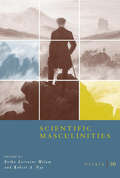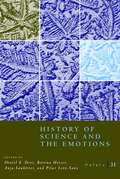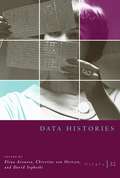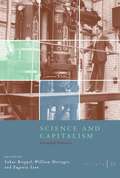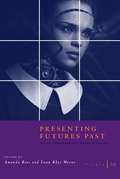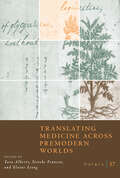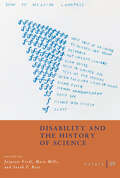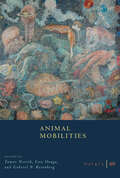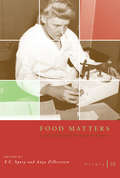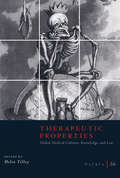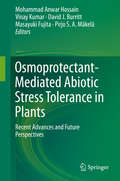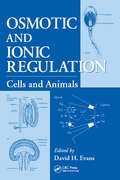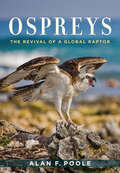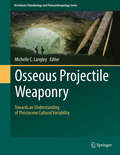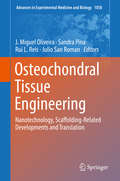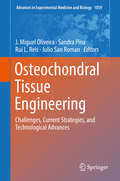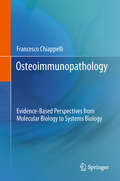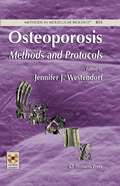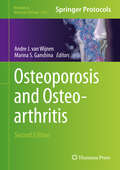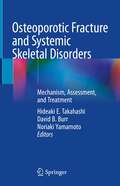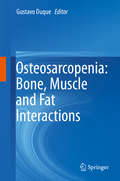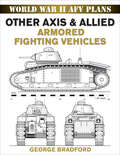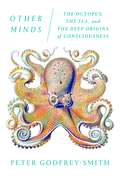- Table View
- List View
Osiris, Volume 30: Scientific Masculinities (Osiris #30)
by The University of Chicago PressThis volume of Osiris integrates gender analysis with the global history of science and medicine from the late Middle Ages to the present by focusing on masculinity. The premise is that social constructions of masculinity function simultaneously as foils for femininity and as methods of differentiating between “kinds” of men. In exploring scientific masculinities, the book asks: how has masculinity been defined, and what are the mechanisms by which it operates in science? The essays are divided into sections that emphasize the importance of gender to the practices of professionalization, the spaces in which scientific, technological, and medical labor is performed, and the ways that sex, gender, and sexual orientation are measured and serve as metaphors in society and culture.
Osiris, Volume 31: History of Science and the Emotions (Osiris #31)
by The University of Chicago PressWhat new insights become available for historians when emotions are included as an analytical category? This volume of Osiris explores the historical interrelationships between science and its cultures and cultures of emotions. It argues that a dialogue between the history of emotions and the history of science leads to a rethinking of our categories of analysis, our subjects, and our periodizations. The ten case studies in the volume explore these possibilities and interrelationships across North America and Europe, between the twelfth and the twentieth centuries, in a variety of scientific disciplines. They analyze how scientific communities approached and explained the functions of emotions; how the concomitant positioning of emotions in or between body-mind-intersubjectivity took place; how emotions infused practices and how practices generated emotions; and, ultimately, how new and emerging identities of and criteria for emotions created new knowledge, new technologies, and new subjectivities.
Osiris, Volume 32: Data Histories (Osiris #32)
by The University of Chicago PressThe history of data brings together topics and themes from a variety of perspectives in history of science: histories of the material culture of information and of computing, the history of politics on individual and global scales, gender and women’s history, as well as the histories of many individual disciplines, to name just a few of the areas covered by essays in this volume. But the history of data is more than just the sum of its parts. It provides an emerging new rubric for considering the impact of changes in cultures of information in the sciences in the longue durée, and an opportunity for historians to rethink important questions that cross many of our traditional disciplinary categories.
Osiris, Volume 33: Science and Capitalism: Entangled Histories (Osiris #33)
by The University of Chicago PressThe historical relationship between science and capitalism has long stood as a central question in science studies, at least since its foundations in the 1930s. Taking inspiration from the recent surge of scholarly interest in the “history of capitalism,” as well as from renewed attention to political economy by historians of science and technology, this Osiris volume revisits this classic quandary, foregrounding the entanglements between these two powerful and unruly historical forces and tracing the diverse ways they mutually shaped each other. Key attention is paid to the practices of knowledge work that enable both scientific and capitalistic action and to the diversity of global sites and circuits in which science/capitalism have been performed. The assembled papers excavate an array of tangled nodes at the science/capitalism nexus, spanning from the seventeenth century to the twenty-first, from Nevada to Central Asia to Japan, from microbiology to industrial psychology to public health.
Osiris, Volume 34: Presenting Futures Past: Science Fiction and the History of Science (Osiris)
by The University of Chicago PressThe role of fiction in both understanding and interpreting the world has recently become an increasingly important topic for many of the human sciences. This volume of Osiris focuses on the relationship between a particular genre of storytelling—science fiction (SF), told through a variety of media—and the history of science. The protagonists of these two enterprises have a lot in common. Both SF and the history of science are oriented towards the (re)construction of unfamiliar worlds; both are fascinated by the ways in which natural and social systems interact; both are critically aware of the different ways in which the social (class, gender, race, sex, species) has inflected the experience of the scientific. Taking a global approach, Presenting Futures Past examines the ways in which SF can be used to investigate the cultural status and authority afforded to science at different times and in different places. The essays consider the role played by SF in the history of specific scientific disciplines, topics, or cultures, as well as the ways in which it has helped to move scientific concepts, methodologies, and practices between wider cultural areas. Ultimately, Presenting Futures Past explores what SF can tell us about the histories of the future, how different communities have envisaged their futures, and how SF conveys the socioscientific claims of past presents.
Osiris, Volume 37: Translating Medicine across Premodern Worlds (Osiris #37)
by The University of Chicago PressHighlights the importance of translation for the global exchange of medical theories, practices, and materials in the premodern period. This volume of Osiris turns the analytical lens of translation onto medical knowledge and practices across the premodern world. Understandings of the human body, and of diseases and their cures, were influenced by a range of religious, cultural, environmental, and intellectual factors. As a result, complex systems of translation emerged as people crossed linguistic and territorial boundaries to share not only theories and concepts, but also materials, such as drugs, amulets, and surgical tools. The studies here reveal how instances of translation helped to shape and, in some cases, reimagine these ideas and objects to fit within local frameworks of medical belief. Translating Medicine across Premodern Worlds features case studies located in geographically and temporally diverse contexts, including ninth-century Baghdad, sixteenth-century Seville, seventeenth-century Cartagena, and nineteenth-century Bengal. Throughout, the contributors explore common themes and divergent experiences associated with a variety of historical endeavors to “translate” knowledge about health and the body across languages, practices, and media. By deconstructing traditional narratives and de-emphasizing well-worn dichotomies, this volume ultimately offers a fresh and innovative approach to histories of knowledge.
Osiris, Volume 39: Disability and the History of Science (Osiris #39)
by The University of Chicago PressPresents a powerful new vision of the history of science through the lens of disability studies. Disability has been a central—if unacknowledged—force in the history of science, as in the scientific disciplines. Across historical epistemology and laboratory research, disability has been “good to think with”: an object of investigation made to yield generalizable truths. Yet disability is rarely imagined to be the source of expertise, especially the kind of expertise that produces (rational, neutral, universal) scientific knowledge. This volume of Osiris places disability history and the history of science in conversation to foreground disability epistemologies, disabled scientists, and disability sciencing (engagement with scientific tools and processes). Looking beyond paradigms of medicalization and industrialization, the volume authors also examine knowledge production about disability from the ancient world to the present in fields ranging from mathematics to the social sciences, resulting in groundbreaking histories of taken-for-granted terms such as impairment, infirmity, epidemics, and shōgai. Some contributors trace the disabling impacts of scientific theories and practices in the contexts of war, factory labor, insurance, and colonialism; others excavate racial and settler ableism in the history of scientific facts, protocols, and collections; still others query the boundaries between scientific, lay, and disability expertise. Contending that disability alters method, authors bring new sources and interpretation techniques to the history of science, overturn familiar narratives, apply disability analyses to established terms and archives, and discuss accessibility issues for disabled historians. The resulting volume announces a disability history of science.
Osiris, Volume 40: Animal Mobilities (Osiris #40)
by The University of Chicago PressSituates "animal mobility" within the politics of movement, opening new perspectives in the history of science. Human societies often come to know the natural world by examining animals, even as animals, frequently both willful and animate, can elude human grasps and challenge human aims. Animals and their movements have underpinned many methodological, moral, and epistemic dilemmas that generatively trouble the field. Featuring a range of geographies, species, languages, and cultures, the contributions in this volume broaden the view of the historical roles animals play in knowledge production processes. Organized according to three scales of animal movement (individuals, groups, systems), the twelve richly illustrated inquiries are situated in different time periods, from the sixteenth-century Ottoman Empire to the recent globalized past, and introduce varied forms, capacities, and politics of movement associated with animals. The analytic attention to animal mobility deepens comprehension of animal agency and human–animal interactions in unexpected spaces, including airports, entertainment venues, living rooms, dirt roads, and waterways. Taken together, the case studies in this volume reconsider how, where, and by whom science is done.
Osiris, volume 35 number 1 (2020)
by OsirisThis is volume 35 issue 1 of Osiris. Founded in 1936 by George Sarton, and relaunched by the History of Science Society in 1985, Osiris is an annual thematic journal that highlights research on significant themes in the history of science. Recent volumes have included Scientific Masculinities, History of Science and the Emotions, and Data Histories.
Osiris, volume 36 number 1 (2021)
by OsirisThis is volume 36 issue 1 of Osiris. Founded in 1936 by George Sarton, and relaunched by the History of Science Society in 1985, Osiris is an annual thematic journal that highlights research on significant themes in the history of science. Recent volumes have included Scientific Masculinities, History of Science and the Emotions, and Data Histories.
Osmoprotectant-Mediated Abiotic Stress Tolerance in Plants: Recent Advances and Future Perspectives
by Vinay Kumar Masayuki Fujita Mohammad Anwar Hossain David J. Burritt Pirjo S. A. MäkeläIn nature, plants are constantly challenged by various abiotic and biotic stresses that can restrict their growth, development and yields. In the course of their evolution, plants have evolved a variety of sophisticated and efficient mechanisms to sense, respond to, and adapt to changes in the surrounding environment. A common defensive mechanism activated by plants in response to abiotic stress is the production and accumulation of compatible solutes (also called osmolytes). This include amino acids (mainly proline), amines (such as glycinebetaine and polyamines), and sugars (such as trehalose and sugar alcohols), all of which are readily soluble in water and non-toxic at high concentrations. The metabolic pathways involved in the biosynthesis and catabolism of compatible solutes, and the mechanisms that regulate their cellular concentrations and compartmentalization are well characterized in many important plant species. Numerous studies have provided evidence that enhanced accumulation of compatible solutes in plants correlates with increased resistance to abiotic stresses. New insights into the mechanisms associated with osmolyte accumulation in transgenic plants and the responses of plants to exogenous application of osmolyte, will further enhance our understanding of the mechanisms by which compatible solutes help to protect plants from damage due to abiotic stress and the potential roles compatible solutes could play in improving plants growth and development under optimal conditions for growth. Although there has been significant progress made in understanding the multiple roles of compatible solute in abiotic stress tolerance, many aspects associated with compatible solute-mediated abiotic stress responses and stress tolerance still require more research. As well as providing basic up-to-date information on the biosynthesis, compartmentalization and transport of compatible solute in plants, this book will also give insights into the direct or indirect involvement of these key compatible solutes in many important metabolic processes and physiological functions, including their antioxidant and signaling functions, and roles in modulating plant growth, development and abiotic stress tolerance. In this book, Osmoprotectant-mediated abiotic stress tolerance in plants: recent advances and future perspectives, we present a collection of 16 chapters written by leading experts engaged with compatible solute-induced abiotic stress tolerance in plants. The main objective of this volume is to promote the important roles of these compatible solutes in plant biology, by providing an integrated and comprehensive mix of basic and advanced information for students, scholars and scientists interested in, or already engaged in, research involving osmoprotectant. Finally, this book will be a valuable resource for future environmental stress-related research, and can be considered as a textbook for graduate students and as a reference book for front-line researchers working on the relationships between osmoprotectant and abiotic stress responses and tolerance in plants.
Osmotic and Ionic Regulation: Cells and Animals
by David H. EvansIn the 40 years since the classic review of osmotic and ionic regulation written by Potts and Parry, there has been astonishing growth in scientific productivity, a marked shift in the direction and taxonomic distribution of research, and amazing changes in the technology of scientific research" It is indicative of the growth of the subject that as
Ospreys: The Revival of a Global Raptor
by Alan F. PooleA fascinating look at one of the greatest conservation success stories of the modern era: the wildly popular, unique, and thrilling raptor, the Osprey.Ospreys are one of the few bird species that are found throughout the world. From forests in Hokkaido to rivers in Oregon and islands off Australia, Ospreys steal the show as nature lovers easily watch them build their massive nests and tend to their young. The fact that the Osprey is one of the few large birds that can hover adds to its mystique, and to watch it plunge into the water, emerging with a fish clutched in its talons, is truly a sight one will remember. As widespread as Ospreys are, not long ago they were under threat of extinction. During the 1950s and '60s, scientists tied the decline of Osprey populations to the heavy use of DDT and other human pollutants. In the 1980s, Ospreys began a slow recovery due to the efforts of conservationists and through the resilience of the adaptable raptors themselves. Today they are again considered common in most parts of the world, although some populations remain threatened.In this gorgeously illustrated book, Alan F. Poole, one of America's premier Osprey experts, has written a lyrical exposé of these majestic creatures, describing their daily habits and exploring their relationship with the environment. Ospreys celebrates the species' miraculous recovery from contaminants and hunters, chronicles their spectacular long-distance migrations, and unveils their vital role in bringing life to coastal habitats. Few other birds have such a hold on the human imagination. This book shows us why.
Osseous Projectile Weaponry
by Michelle C. LangleyThis volume presents the current state of knowledge on the osseous projectile weaponry that was produced by Pleistocene cultures across the globe. Through cross-cultural and temporal comparison of manufacturing methods, design, use methods, and associated technology, chapters in this volume identify and discuss differences and similarities between these Pleistocene cultures. The central research questions addressed in this volume include: (a) how did osseous weaponry technology develop and change through time and can these changes be tied to environmental and/or social influences?; (b) how did different Pleistocene cultures design and adapt their osseous weaponry technology to their environment as well as changes in that environment?; and (c) can we identify cultural interaction between neighboring groups through the analysis of osseous weapons technology -- and if so -- can we use these items to track the movement of peoples and/or ideas across the landscape? Through addressing these three central research questions, this volume creates an integrated understanding of osseous technology during a vital period in Modern Human cultural development which will be useful for students and advanced researchers alike.
Osteochondral Tissue Engineering: Challenges, Current Strategies, And Technological Advances (Advances In Experimental Medicine And Biology #1059)
by Rui L. Reis J. Miguel Oliveira Sandra Pina Julio San RomanThis book reviews the most recent developments in the field of osteochondral tissue engineering (OCTE) and presents challenges and strategies being developed that face not only bone and cartilage regeneration, but also establish osteochondral interface formation in order to translate it into a clinical setting. Topics include nanotechnology approaches and biomaterials advances in osteochondral engineering, advanced processing methodology, as well as scaffolding and surface engineering strategies in OCTE. Hydrogel systems for osteochondral applications are also detailed thoroughly. Osteochondral Tissue Engineering: Nanotechnology, Scaffolding-Related Developments and Translation is an ideal book for biomedical engineering students and a wide range of established researchers and professionals working in the orthopedic field.
Osteochondral Tissue Engineering: Challenges, Current Strategies, And Technological Advances (Advances In Experimental Medicine And Biology #1059)
by Rui L. Reis J. Miguel Oliveira Sandra Pina Julio San RomanThis book covers the most recent developments in the field of osteochondral tissue engineering (OCTE) and covers in detail the concepts and current challenges for bone and cartilage repair and regeneration. Specific topics include viscosupplementation, biologicals, tissue engineering approaches, in vitro and in vivo models, and technological advances with stem cells, bioreactors, and microfluidics. Osteochondral Tissue Engineering: Challenges, Current Strategies, and Technological Advances presents challenges and strategies in the field of osteochondral regeneration and serves as a core reference for biomedical engineering students and a wide range of established researchers and professionals working in orthopedics.
Osteoimmunopathology
by Francesco ChiappelliOsteoimmunology pertains to the study of the relationship between the bones, particularly the bone marrow, and the immune system. This monograph pursues the best available evidence, by means of research synthesis, for the characterization of the physiological relevance and pathological implications of the inter-connectedness between the skeletal and the immune system. Research will be discussed that highlights the associated role of the circulatory, nervous and endocrine systems, as well as proteomic and genomic pathways and signatures. Emphasis is given that domain of medicine that relates to the oral cavity, its diseases and their systemic sequelae. This monograph arises from observations that have suggested that the skeletal system and the immune system are intimately intertwined. Chronic inflammatory reactions subsequent to an excessive immune reaction can damage the bones, as in rheumatoid arthritis (RA), osteoporosis, patients seropositive for the human immunodeficiency virus (HIV)-1 and with signs and symptoms of the acquired immune deficiency syndrome (AIDS), and bone cancer. Bones - in particular the bone marrow - are one of the primary locations in which cells of the immune system mature. In brief, this monograph begins to answer a range of questions, such as, what is osteoimmunology all about?, does the immune system and its components affect bone development?, how do stress hormones impact upon the pathophysiology of bone-immune interactions?, can the scientific process of research synthesis, obtain the best available evidence for treatment of diseases involving the bone-immune entity (i.e., osteo immunopathologies) means of evidence-based clinical decision-making directed at the treatment of osteoimmune pathologies?
Osteoporosis
by Jennifer WestendorfThe study of bone cells and tissues at the cellular and molecular levels in a variety of models has revolutionized the field. In this book, leading scientists from around the world share their step-by-step laboratory protocols for studying bone biology. This is the perfect guide for both new and experienced experimentalists attempting to study osteoporosis.
Osteoporosis and Bone Densitometry Measurements
by Giuseppe GuglielmiOsteoporosis is a serious problem worldwide, and its significance is continuing to increase as the world population grows and ages. Osteoporosis and Bone Densitometry Measurements provides a comprehensive review of the latest research on this potentially devastating condition. The book encompasses prevention, diagnosis, and therapy, providing state of the art information on each aspect. A wide range of topics are discussed, including differentiation between acute and chronic, benign and malignant vertebral fractures; the value of the WHO FRAX tool in patient evaluation; the roles of dual-energy X-ray absorptiometry, quantitative computed tomography, quantitative ultrasound, and high-resolution imaging; and the use of kyphoplasty and vertebroplasty to treat vertebral compression fractures. All chapters are written by acknowledged experts in the field.
Osteoporosis and Osteoarthritis (Methods in Molecular Biology #2221)
by Andre J. van Wijnen Marina S. GanshinaThis detailed second edition provides key updates on well-established methods as well as coverage of recently emerging sophisticated techniques and methods that are essential for an in-depth and state-of-the-art understanding of skeletal development and homeostasis and the pathological mechanisms that cause skeletal degeneration. The first half of the book examines cell and molecular biological aspects of osteoarthritis and osteoporosis, while the remainder of the collection focuses on in vivo models of skeletal tissue injury, degeneration, and repair. Written for the highly successful Methods in Molecular Biology series, chapters include introductions to their respective topics, lists of the necessary materials and reagents, step-by-step, readily reproducible laboratory protocols, and tips on troubleshooting and avoiding known pitfalls. Authoritative and up-to-date, Osteoporosis and Osteoarthritis, Second Edition aims to assist investigators concerned with research topics broadly related to osteoporosis, osteoarthritis, intervertebral disc degeneration, as well as other musculoskeletal disorders.
Osteoporotic Fracture and Systemic Skeletal Disorders: Mechanism, Assessment, and Treatment
by David B. Burr Hideaki E. Takahashi Noriaki YamamotoThis edited book describes what fragile bone is, how the condition is assessed, and how it can be treated. It is intended for multi-professional trainees and practitioners in health and social care fields who care for and treat the elderly.Chapters within the book provide the latest advances in cell and molecular biology, morphology, radiology, and the biomechanics of bone in health and disease. The basic concept of “Remodeling” and “Modeling” is described for better understanding of the mechanisms of osteoporosis. Methods of identifying and assessing osteoporosis are described, as are risk factors for bone fracture and non-unions. Furthermore, the effects of various drugs used to treat osteoporosis at both material and structural levels of bone and their cost effectiveness are described. Operative treatments for fracture that maintain or improve the quality of life of patients are includedTreatment of Osteoporotic Fracture and Systemic Skeletal Disorders attempts to provide a holistic and translational view of the pathogenesis and treatment of osteoporosis and some other musculoskeletal diseases, with an overview of treatment modalities in various clinical settings.
Osteosarcopenia: Bone, Muscle and Fat Interactions
by Gustavo DuqueThis edited work presents the most current evidence on osteosarcopenia from bench to bedside, which is expected to facilitate the understanding of this syndrome and to develop preventive and therapeutic strategies. With our aging population, chronic diseases such as osteoporosis and sarcopenia are becoming highly prevalent. Fortunately, our understanding of the bone and muscle interactions has increased in recent years. This has allowed to the coining of the term osteosarcopenia to describe a syndrome in which these two diseases overlap. This overlap between osteoporosis and sarcopenia has major negative effects not only on our older adults but also on health systems worldwide. Readers will find a highly translational approach that starts with a summary of recent discoveries on stem cells biology, muscle and bone interactions – including the role of local bone and muscle fat – followed by comprehensive reviews on myokines (i.e. myostatin), osteokines (i.e. osteocalcin) and adipokines (i.e. interleukins) as major players and determinants of bone and muscle loss with aging. In addition, the role of sex steroids (i.e. estrogens, androgens), and calciotropic hormones (i.e. parathyroid hormone, vitamin D) in the pathogenesis of this syndrome is also reviewed. Moreover, using practical diagnostic and therapeutic tips, this book summarizes the clinical characteristics of osteosarcopenic patients thus facilitating the diagnosis and treatment of this syndrome in clinical practice. Finally, the book presents the case for the Falls and Fractures Clinic as the optimal model of care for this syndrome, aimed to avoid fragmentation and optimize osteosarcopenia care, and simultaneously prevent falls and fractures in older persons.This book offers relevant information on the mechanisms of osteosarcopenia, and a practical guide on how to identify and treat this geriatric syndrome and its adverse outcomes, which are dramatically affecting our aging population.The work is written by leaders in the field and is especially suited not only to any researcher in the musculoskeletal arena but also to medical specialists and allied health professionals involved in the care of older persons.
Ostriches (Superpower Field Guide)
by Rachel PoliquinThis third installment in the hilarious and highly-illustrated full-color Superpower Field Guide series features the silly-looking, surprisingly fierce Ostrich. This two-toed torpedo may have the largest eyes of any animal on dry land, but it can outrun most horses! Meet Eno, an ordinary ostrich living in the Serengeti, a corner of the African savanna. But there's something you should know: Even ordinary ostriches are extraordinary. And that includes Eno. I know what you&’re thinking. You&’re thinking that ostriches are just overgrown chickens with ridiculous necks, skinny legs, and bad attitudes. And you&’re right! Believe it or not, that neck helps ostriches run at supersonic speeds. Those skinny legs can kill a lion dead. And these are only a few weapons in Eno's arsenal of superfierce survival skills—Eno has Colossal Orbs of Telescopic Vision, the Impossible Ever-Flow Lung, the Egg of Wonder, and so many more. You&’re still not convinced that ostriches are superpowered, are you? Well, you don&’t know ostriches yet. But you will.
Other Axis & Allied Armored Fighting Vehicles: World War II AFV Plans (AFV Plans)
by George BradfordThis fully illustrated volume presents an authoritative and highly detailed study of WWII&’s lesser-known armored fighting vehicles. The iconic tanks of WWII, such as America&’s Shermans and the Germany&’s Panzers, have been exhaustively studied. In Other Axis & Allied Armored Fighting Vehicles, military historian and technical artist George Bradford offers an in-depth look at a range of significant yet often-overlooked models. This volume is filled with fine-scale drawings of Australian, Belgian, Canadian, Czech, French, Hungarian, Italian, Japanese, Polish, Romanian, and South African armored vehicles, including: · Centauro Tank Destroyer (Italy) · TKS Light Reconnaissance Tank (Poland) · Ram &“Kangaroo&” Personnel Carrier (Canada) · Renault R-35 Light Tank (France) · Type 3 Chi-nu Heavy Tank (Japan) · Scorpion AC1 Cruiser Tank (Australia) · TACAM R-2 Tank Hunter (Romania) · And many, many more . . .
Other Minds: The Octopus, the Sea, and the Deep Origins of Consciousness
by Peter Godfrey-SmithAlthough mammals and birds are widely regarded as the smartest creatures on earth, it has lately become clear that a very distant branch of the tree of life has also sprouted higher intelligence: the cephalopods, consisting of the squid, the cuttlefish, and above all the octopus. In captivity, octopuses have been known to identify individual human keepers, raid neighboring tanks for food, turn off lightbulbs by spouting jets of water, plug drains, and make daring escapes. How is it that a creature with such gifts evolved through an evolutionary lineage so radically distant from our own? What does it mean that evolution built minds not once but at least twice? The octopus is the closest we will come to meeting an intelligent alien. What can we learn from the encounter? <P><P>In Other Minds, Peter Godfrey-Smith, a distinguished philosopher of science and a skilled scuba diver, tells a bold new story of how subjective experience crept into being―how nature became aware of itself. As Godfrey-Smith stresses, it is a story that largely occurs in the ocean, where animals first appeared. Tracking the mind’s fitful development, Godfrey-Smith shows how unruly clumps of seaborne cells began living together and became capable of sensing, acting, and signaling. As these primitive organisms became more entangled with others, they grew more complicated. The first nervous systems evolved, probably in ancient relatives of jellyfish; later on, the cephalopods, which began as inconspicuous mollusks, abandoned their shells and rose above the ocean floor, searching for prey and acquiring the greater intelligence needed to do so. Taking an independent route, mammals and birds later began their own evolutionary journeys. <P><P>But what kind of intelligence do cephalopods possess? Drawing on the latest scientific research and his own scuba-diving adventures, Godfrey-Smith probes the many mysteries that surround the lineage. How did the octopus, a solitary creature with little social life, become so smart? What is it like to have eight tentacles that are so packed with neurons that they virtually “think for themselves”? What happens when some octopuses abandon their hermit-like ways and congregate, as they do in a unique location off the coast of Australia? <P><P>By tracing the question of inner life back to its roots and comparing human beings with our most remarkable animal relatives, Godfrey-Smith casts crucial new light on the octopus mind―and on our own.
